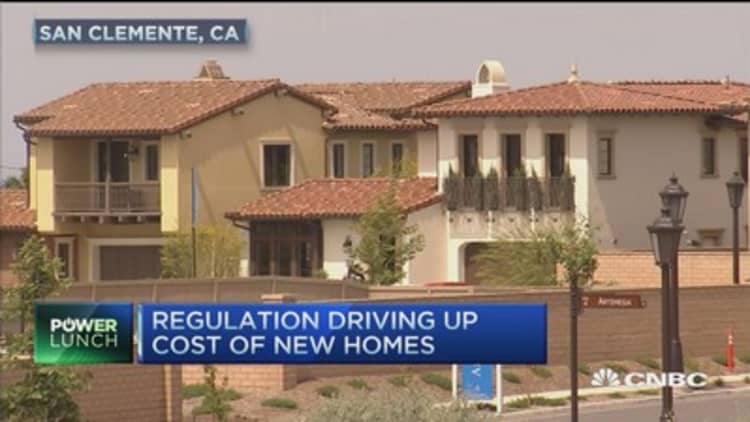
As the Pacific waves crash below, the frames of luxury homes rise above — in what is being called the last seaside development in Southern California. Sea Summit in San Clemente is finally open, selling million-dollar homes in a local housing market that can afford the lofty price tag.
Arizona-based Taylor Morrison and its financial partners purchased the project two years ago, reportedly for $200 million. Previous developers, dating back 40 years, had failed to finish the project. The recession was the latest killer, but strict new regulation, federal, state and local, have made the project far more expensive today than it would have been decades ago.
"The requirements for this project have been enormous, there is no question about it," said Phil Bodem, president of the Southern California division of Taylor Morrison.
The boundaries of the original master plan area were about 250 acres; today 50 acres of that is commercial, and the rest is residential. Of the residential area, however, only 100 acres are dedicated to streets and home sites. Taylor Morrison has planned 309 homes, about half the number it could have built decades ago. The rest of the land is mandated open space, public trails and new vegetation, all funded by developers. The cost of new development, not just in California, but across the nation, is rising dramatically, due to new regulations.
"Every time you turn around there's a new regulation. If a piece of property has water on it for more than 30 days, it's now considered a wetland. The governments are worried about storms and the nails running into the ocean. Everywhere you turn it's getting more and more expensive to build a home, and it's taking longer to get it built," said John Burns of California-based John Burns Real Estate Consulting.
Burns surveyed more than 100 homebuilding executives across the nation and said he heard, "many horror stories of cost increases that were far more than just materials and labor." Erosion control, energy codes, fire sprinklers, mortgage documentation and closing costs under new mortgage compliance rules are all combining to drive costs higher for builders and home prices up for buyers.
"It's a lot of good things to protect the environment, but it's making building affordable homes virtually impossible," added Burns.
That is why Sea Summit will likely be the last of its coastal kind, and it is why the homes there start at just shy of $1 million and rise from there. Taylor Morrison bought the project when it was already mostly developed, but the company still had to invest more.
"No. 1, you see it in just the pure requirements. Those requirements can be a very lengthy list of things you maybe wouldn't have seen 10, 15, 20 years ago. But you're also seeing it in fees that counties and cities impose on new home construction. Fees can be anywhere from $50,000 to $100,000 per home to build," said Taylor Morrison's Bodem. "Things like that ultimately get passed on to the consumer and the price of housing. That's one reason why you see the cost of housing so expensive, especially here in Southern California."
How much more expensive? Compliance costs make up 24 percent of the cost of a newly built home, and as home prices rise that share isn't changing, meaning the costs to buyers is rising. The cost of compliance with government regulations has increased the price of a new home, on average, by 30 percent in the last five years, according to a survey by the National Association of Home Builders.
"The costs imposed during construction increased the fastest, rising by almost 50 percent, but even the more modest change in the impact of regulation imposed during development represents a 19.1 percent increase," wrote Paul Emrath, economics and housing policy analyst at NAHB
The supply of entry-level existing homes for sale in the United States is historically low and falling. It would seem like a great opportunity for homebuilders, but instead they are turning away from the product because they simply can't afford the rising costs of both land and new regulations on that land and on construction.
"When you start with a high land basis, it's very hard to end up with a purchase price that the first-time buyer finds affordable," said Stuart Miller, CEO of Miami-based Lennar at a homebuilder conference held this week by JP Morgan.
Only DR Horton, the largest U.S. homebuilder, has an entry-level product. The sheer volume of homes it builds allows it to do what other builders either can't or don't want to do.
"There is much bigger demand at the entry level. They would love to do entry level. They just need to be able to make money to do it, and it's getting increasingly hard to build a home for less than $250,000," said Burns.



